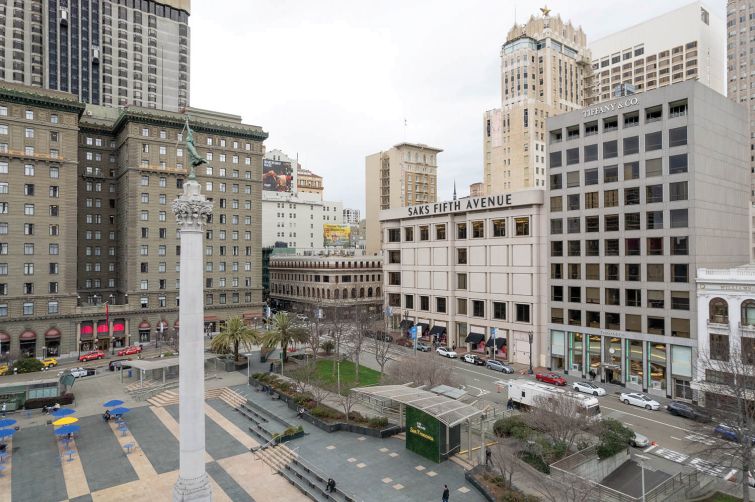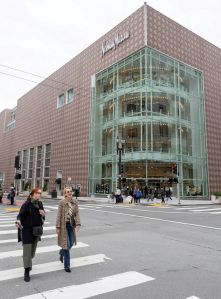Bay It Forward: The Case for Optimism in San Francisco Retail
By Mark Hallum February 28, 2024 10:00 am
reprints
Mark Twain is said to have noted that the “coldest winter I ever spent was a summer in San Francisco,” and, while that city’s office market has been on ice for sure, retail is giving real estate observers reason to believe that things are going to warm up in the long run.
After all, just because people aren’t going into the office does not mean they’ve left the Bay Area entirely or that they’re unemployed. If anything, they are doing a little shopping, getting a bite to eat, and creating a commercial real estate ecosystem that revolves around more than skyscrapers.
That’s what brokers and analysts have been trying to say and nobody is listening: that San Francisco isn’t all about empty office towers, rampant homelessness, and drug addicts commandeering public spaces.
Brokers trying to make the best of the San Francisco retail market aren’t blind to the problems in and around the city. They are, however, finding ways to make the market work for them while taking solace in data showing that things are moving in the right direction.
Downtown San Francisco’s retail economic rent, which was calculated by CBRE (CBRE) as the average asking rent multiplied by occupancy rate, was down 14 percent from pre-pandemic levels between the third quarter of 2019 through the third quarter of 2023, but it was up 26 percent on an annual basis.
Foot traffic in Union Square, an upscale retail drag, was down 45 percent in October from pre-pandemic levels, according to CBRE, with many of those shoppers instead going to nearby Fillmore Street, where foot traffic grew 1 percent over pre-pandemic levels as of the end of the third quarter and grew 13 percent year-over-year.
By the end of the fourth quarter, Union Square’s vacancy had hit 20.5 percent, an 18.7 percent quarterly increase from 14.2 percent at the end of 2022, according to a report from Cushman & Wakefield, which noted that citywide retail vacancy had hit its highest point in recorded history.
But Union Square is hardly losing out on customers entirely after Banana Republic, Ikea and Chotto Matte signed deals and opened in 2023, contributing to a 3 percent increase in foot traffic year-over-year. The Cushman & Wakefield report noted that a foot traffic report from business improvement district Union Square Alliance showed the total number of visitors increased in 2023 by 7.3 percent from 2022, equaling 13.4 million for the year.
Suburban markets are performing the best in the Bay Area, with rent in South San Francisco, Daly City and Brisbane growing consistently over 5 percent from pre-pandemic levels.
Ben Lazzareschi, managing director and retail broker for JLL (JLL) in San Francisco, sees retail in the Bay Area as something resilient but unpredictable, with the pandemic unseating the old, reliable patterns. The city has also become a “punching bag” for pundits when its problems are hardly unique, he told Commercial Observer.
“It’s a very scattered market in the sense that you have neighborhoods performing very, very well, at or exceeding pre-COVID levels,” Lazzareschi said. “Then you have some that are not performing as well as some that are seeing higher vacancy rates and more of a struggling pedestrian and retail environment for the retailers. … There’s not one precise answer as to why that is happening. It’s just kind of how things have panned out.”
A lack of demand for office still has its stranglehold on Downtown, the Financial District and the Union Square areas of San Francisco, however, as operating costs such as employee overhead and insurance remain high. This, according to Lazzareschi, is one of the bigger factors pushing retailers toward other markets in the Bay Area even though rent is declining in the city’s core areas.
High-profile burglaries in Union Square have also deterred shoppers.
“If they don’t feel safe, that money is going to be spent where they do feel safe, and if you look at the village of Corte Madera, which is to the north, sales are up 30 percent,” Lazzareschi said, referencing a suburb. “When you go down to Stanford in Palo Alto, sales are up, so what that tells you is the consumer that was coming into Union Square from outside the city is choosing to go to those markets to spend their dollars.”
OK, not great for San Francisco proper, but the state is helping.
In 2023, California provided $267 million to law enforcement to combat retail theft by creating investigative units, while providing resources for surveillance technology, hiring loss-prevention personnel, and building relationships between businesses and communities, according to CBRE.
And some retailers are seeing a future in San Francisco. The same trends that are changing perceptions about New York City are also changing those in the Bay Area, specifically with the $63 million sale of 40 Post Street in February 2022, formerly owned by William-Sonoma, to Chanel.

“Now, I want to be clear: I do think that will change — you’re never going to be able to re-create Union Square in Palo Alto or in Corte Madera,” Lazzareschi added. “But the perception is still somewhat negative and I think until that changes, along with some new fresh retailers coming into the market, you’re still going to have a bit of a reticence to come into and shop that market; and therefore, if the sales aren’t there, the retailers don’t follow, right?”
The deal was somewhat similar to the sales of Wharton Properties buildings in Midtown Manhattan to Prada and Kering — parent of Gucci and Balenciega — in the past several weeks, each for close to $1 billion.
“I think when you’re a major luxury brand, and you’re paying these incredibly high rents, it does make sense, I think,” Lazzareschi said. “The challenge is they’re just typically not set up to own and therefore operate real estate, but I think what they’re realizing is that financially it makes a lot of sense to purchase it and then you can hire a property manager.”
Retail rents may have been halved in places like Union Square since the pandemic as well, but some brokers in the Bay Area see only a glass half full, with opportunities to fill the rest of the proverbial glass. In other words, there’s enough available space for occupiers to pick and choose, and the prices are considered reasonable, CBRE’s Brandon Isner told CO in December.
“Retail is so exposed to public perception. It’s the only commercial real estate type where we choose to spend our spare time,” said Isner, CBRE’s head of retail research for the Americas. “News comes through so quickly, and you might see ‘Rents dropped 50 percent.’ Yeah, but that’s where they should be.”
Isner explained that a similar situation had taken place in Miami Beach, where rents were around $300 per square foot before the pandemic, when everything bottomed out to $150 to $200 per square foot. That was when tenants such as Shake Shack and Cheesecake Factory began seizing the day on Lincoln Road, a major retail route through the area.
San Francisco has more potential as a business hub, CBRE’s Alex Sagues told CO in the same interview as Isner, with tourism feeding the retail industry at 90 percent of pre-pandemic levels. This is happening while the hospitality industry has enjoyed renewed demand after the pandemic, even as the supply of hotels and other hospitality amenities remains limited due to construction costs and political headwinds.
“I’d say the biggest challenge we have in San Francisco is the complexity to get open, and then cost,” Sagues said.
Due to the cost of labor and building out space, restaurants are one retail segment that is facing an uphill battle in San Francisco. As a result, retailers who once did ground-up builds of free-standing eateries in-house are turning to real estate investment trusts and other large landlords to rent space in shopping centers and similar properties.
These major landlords, including REITs, present the best option for national retailers since larger organizations tend to track all the data on buildings to better inform the tenant of whether the property can accommodate their utility requirements, whereas small, family owners may not be able to provide such comprehensive data, according to Sagues.
The exposure of these markets to luxury retail is one of the biggest reasons why places such as Union Square are hit hard and take time to rebuild momentum, a side effect of its premium status.
“Union Square is always coming out of these recessions or market downturns being hit the hardest,” JLL’s Lazzareschi said. “And part of that reason is that it’s some of the highest rents in the entire city — and also some of the highest rents, frankly, nationally.”
Mark Hallum can be reached at mhallum@commercialobserver.com.


